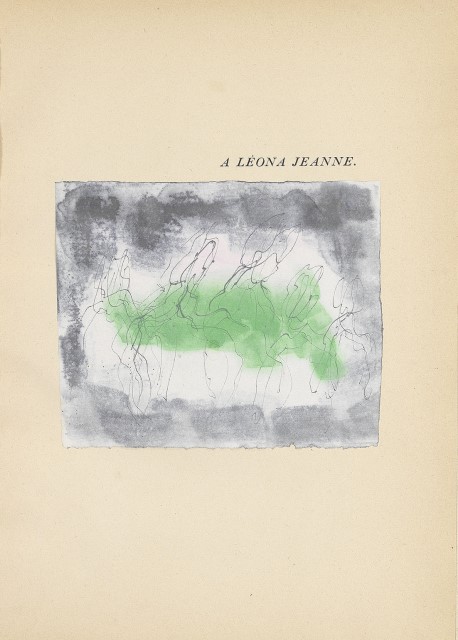Orénoque by Robert Ganzo 1942
Jean Fautrier
* 1898 in Paris † 1964 in Chatenay-Malabry
Etching and aquatint. 39.5 x 29 cm.
Deluxe copy with one gouache on japan paper (15.6 x 18.5 cm) and the additional set of 10 prints on Japan. Printed on Richard de Bas laid paper, some sheets watermarked Orénoque, title page with etched vignette, text, justification and set of eleven (ten en-texte, one hors-texte) with the additional of 10 suite on Japan hors-texte and the original gouache applied to dedication page included in this edition, copy number 18 from the edition of twenty (the total edition was 84), the full sheets as published, bound in elaborate embroidered cloth-covered boards, vellum title label on spine with title impressed in gilt(album). Published by Librairie Auguste Blaizot, Paris.
Literature: Mason 63-73.
Price on request
Jean Fautrier’s abstract etchings of the decapitated body and severed head, disguised as the flowing waters of a river in the artist’s book Orénoque are landmark symbols of protest at the wartime atrocities in France. Commissioned by French publisher Georges Blaizot during the German Occupation, Fautrier’s etchings transformed Robert Ganzo’s nostalgic poems of the rivers and forests of his Venezuelan childhood into an instrument of cultural resistance. Using the book as a vehicle and Ganzo’s poems as camouflage, Fautrier circumvented the barrier of fear and censorship of the Occupation. The text and images independently cohabited the same book space, each telling a different story, in a rendition of the modernist and “degenerate art” that had been condemned. This paper reveals the influence and timing of the socio-political events during the Second World War on the increased radicalisation of Fautrier’s art which led to the creation of the Orénoque images. This paper also establishes an aesthetic and symbolic link between the etchings in Orénoque and Fautrier’s landmark Les Otages series of resistance paintings and shows that they shared the same illustrative concepts of death and the dismembered body, and they convey the same message of protest. As such Orénoque represents an important milestone in the history of the French artist’s books and as a book of cultural protest during the German Occupation of France. (Extract from: Rodney T. Swan. Orénoque as a Book of Cultural Protest: Fautrier’s Brutal Etchings Camouflaged by Ganzo’s Poetic River)
In this form extremely rare. There has been only one other deluxe copy on the market since ours (Christie's London: Wednesday, December 9, 1998 [Lot184], Important Old Master, Nineteenth Century and Twentieth Century Prints). The other one from the P. Berge collection offered in Paris in Christies Paris 12/4/2002 lot 127 (Estimated at 60-80.000 Euros)
